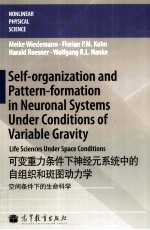

可变重力条件下神经元系统中的自组织和斑图动力学 空间条件下的生命科学(英文版)PDF电子书下载
- 电子书积分:9 积分如何计算积分?
- 作 者:Hanke等著
- 出 版 社:北京市:高等教育出版社
- 出版年份:2010
- ISBN:9787040294743
- 页数:200 页
Chapter 1 Introduction 1
1.1 Historical remarks 1
1.1.1 Gravitational research 1
1.2 Excitable media and their control by small external forces 2
1.3 Waves and oscillations in biological systems 3
1.4 Book layout 4
References 5
Chapter 2 Gravity 7
2.1 Physical remarks 7
2.2 Perception of gravity by living systems 8
References 9
Chapter 3 Basic Structure of Neuronal Systems 11
References 18
Chapter 4 Platforms for Gravitational Research 19
4.1 Microgravity platforms 20
4.1.1 Short term platforms 21
4.1.2 Long term platforms 31
4.1.3 Magnetic levitation 34
4.2 Removing orientation 36
4.2.1 Clinostats 37
4.2.2 Random positioning machine 37
4.3 Macro-gravity platforms 38
4.3.1 Centrifuge 39
References 41
Chapter 5 A Model Systems for Gravity Research:The Belousov-Zhabotinsky Reaction 43
5.1 Setup for the Belousov-Zhabotinsky experiments 44
5.2 Preparation of gels for the Belousov-Zhabotinsky reaction 46
5.3 Data evaluation 46
References 55
Chapter 6 Interaction of Gravity with Molecules and Membranes 57
6.1 Bilayer experiments 58
6.1.1 Hardware for the Microba mission 60
6.1.2 Hardware for the drop-tower 62
6.1.3 Hardware for parabolic flights 62
6.1.4 Hardware for laboratory centrifuge 64
6.1.5 Experimental results 64
6.2 Patch-clamp experiments 69
6.2.1 Principles of patch-clamp experiments 69
6.2.2 Hardware for the drop-tower 71
6.2.3 First hardware for parabolic flights 75
6.2.4 For the drop-tower 76
6.2.5 First parabolic flight experiment 77
6.2.6 Second hardware for parabolic flights 78
6.2.7 Second parabolic flight experiment 86
6.2.8 First results and future perspectives 89
References 92
Chapter 7 Behavior of Aetion Potentials Under Variable Gravity Conditions 95
7.1 Introductory remarks 95
7.2 Materials and methods 99
7.3 Isolated leech neuron experiments 100
7.4 Earthworm and nerve fiber experiments(rats and worms) 102
7.5 Discussion 105
References 108
Chapter 8 Fluorescence and Light Scatter Experiments to Investigate Cell Properties at Microgravity 111
8.1 Fluorescence measurements to determine calcium influx and membrane potential changes 111
8.1.1 Intracellular calcium concentration experiments 112
8.1.2 Membrane potential experiments 113
8.2 Light scatter experiments to determine changes in cell size 114
8.2.1 Static light scatter 115
8.2.2 Dynamic light scatter 118
References 121
Chapter 9 Spreading Depression:A Self-organized Excitation Depression Wave in Different Gravity Conditions 123
9.1 The retinal spreading depression 124
9.2 Gravity platforms used for retinal spreading depression experiments 126
9.2.1 Methods 127
9.2.2 Experiment setup and protocol for spreading depression experiments in parabolic flights 128
9.2.3 Experiment setup and protocol for spreading depression experiments on TEXUS sounding rocket 129
9.2.4 Setup and protocol for spreading depression experiments in the centrifuge 132
9.2.5 Data analysis 132
9.3 Results 134
9.3.1 Spreading depression experiments in parabolic flights and in the centrifuge 134
9.3.2 Spreading depression experiments on sounding rockets and in the centrifuge 136
9.3.3 Determination of latency of spreading depression waves in the centrifuge 138
9.3.4 Summary of all spreading depression experiments on different gravity platforms 139
9.4 Discussion 140
9.4.1 Comment on different gravity platforms 141
References 142
Chapter 10 The Brain Itself in Zero-g 145
10.1 Methods 147
10.1.1 Slow cortical potentials(SCP) 148
10.1.2 Classical frequency bands in EEG 149
10.1.3 Peripheral psycho physiological parameters 150
10.1.4 Protocol and data analysis 150
10.1.5 Subjects 152
10.1.6 Ethic 153
10.2 Results 153
10.2.1 Slow Cortical Potentials(SCP) 154
10.2.2 Frequency band EEG 157
10.2.3 Peripheral stress parameters 159
10.3 Discussion 161
10.3.1 Slow cortical potentials 161
10.3.2 Frequency band EEG 162
10.3.3 Peripheral parameters 163
10.4 Conclusion 163
References 164
Chapter 11 Effects of Altered Gravity on the Actin and Microtubule Cytoskeleton,Cell Migration and Neurite Outgrowth 167
11.1 Summary 167
11.2 Introductory remarks 168
11.3 Material and methods 169
11.3.1 Cell transfection 169
11.3.2 Cell culture and experiments with SH-SY5Y neuroblastoma cells 169
11.3.3 Cell migration experiments-Human carcinoma cell lines 170
11.3.4 Scratch Migration Assay(SMA) 170
11.3.5 Neurite outgrowth experiments-Primary cell culture of embryonic chicken spinal cord neurons 170
11.3.6 Imunostaining of cells 171
11.3.7 Staining of F-actin 171
11.3.8 Microscopy and live imaging 171
11.4 Results and discussion 172
11.4.1 Effects of altered gravity on actin-driven lamellar protrusion of SH-SY5Y neuroblastoma cells 172
11.4.2 Effect of altered gravity on the microtubule cytoskeleton of SH-SY5Y neuroblastoma cells 177
11.4.3 Effects of altered gravity on cell migration 181
11.4.4 Effects of altered gravity on the intensity and direction of neurite outgrowth 182
References 184
Chapter 12 Discussion and Perspectives 187
References 192
Index 193
- 《异质性条件下技术创新最优市场结构研究 以中国高技术产业为例》千慧雄 2019
- 《流体力学》张扬军,彭杰,诸葛伟林编著 2019
- 《工程静力学》王科盛主编 2019
- 《空气动力学 7 飘浮的秘密》(加)克里斯·费里著 2019
- 《中国退役动力电池循环利用技术与产业发展报告》中国科学院过程工程研究所,资源与环境安全战略研究中心,中国物资再生协会编著 2019
- 《材料力学 上》杨在林,杨丽红主编 2011
- 《流体力学与传热学》潘小勇编著 2019
- 《材料力学 第2版》严圣平,马占国 2018
- 《野村重存的水彩魔法课》魏笑可译;(日本)野村重存 2019
- 《海洋油气计算流体力学》朱红钧编 2016
- 《全国高等中医药行业“十三五”创新教材 中医药学概论》翟华强 2019
- 《培智学校义务教育实验教科书教师教学用书 生活适应 二年级 上》人民教育出版社,课程教材研究所,特殊教育课程教材研究中心编著 2019
- 《指向核心素养 北京十一学校名师教学设计 英语 七年级 上 配人教版》周志英总主编 2019
- 《习近平总书记教育重要论述讲义》本书编写组 2020
- 《办好人民满意的教育 全国教育满意度调查报告》(中国)中国教育科学研究院 2019
- 《高等数学试题与详解》西安电子科技大学高等数学教学团队 2019
- 《北京生态环境保护》《北京环境保护丛书》编委会编著 2018
- 《教育学考研应试宝典》徐影主编 2019
- 《语文教育教学实践探索》陈德收 2018
- 《家庭音乐素养教育》刘畅 2018
